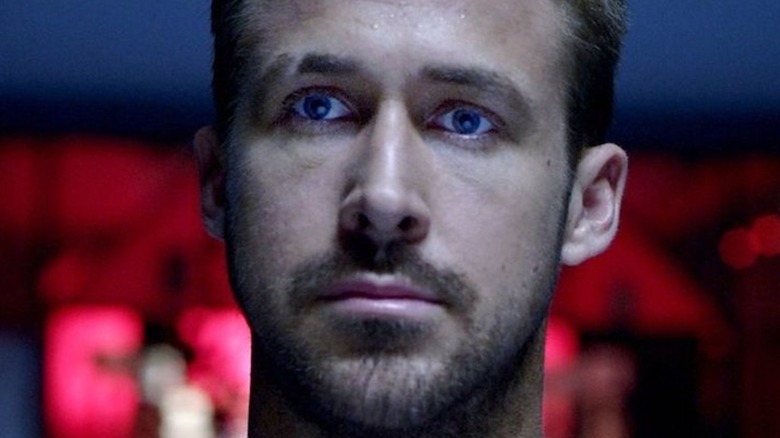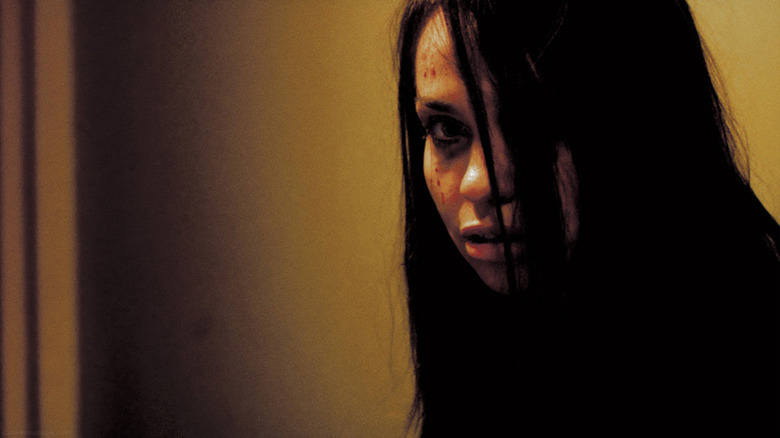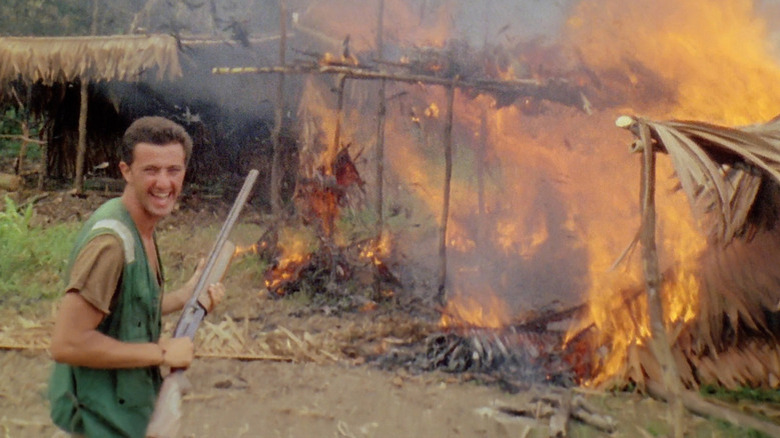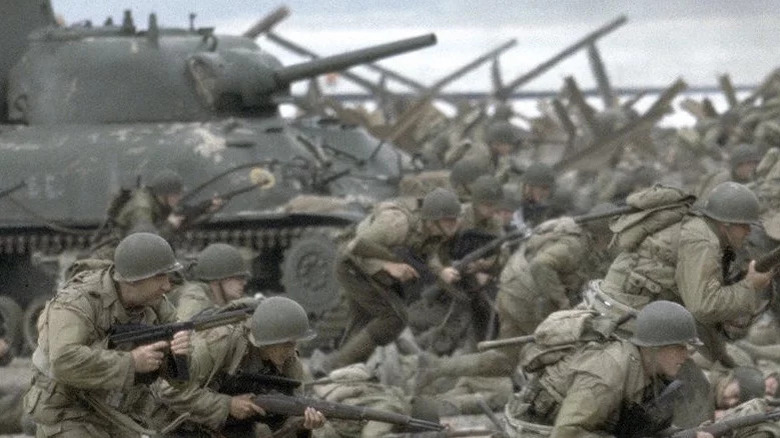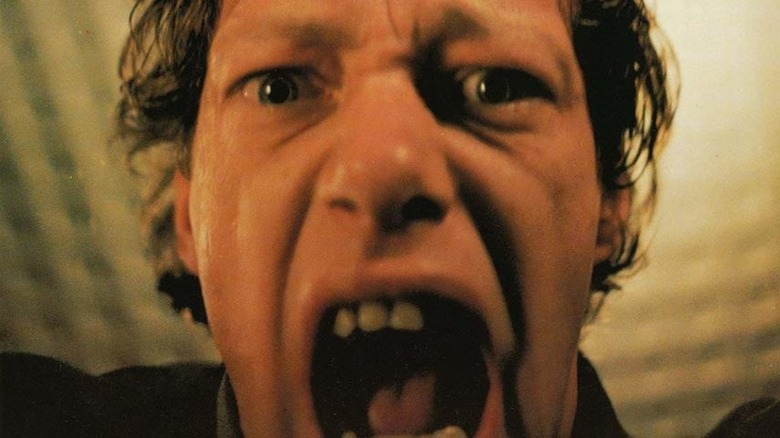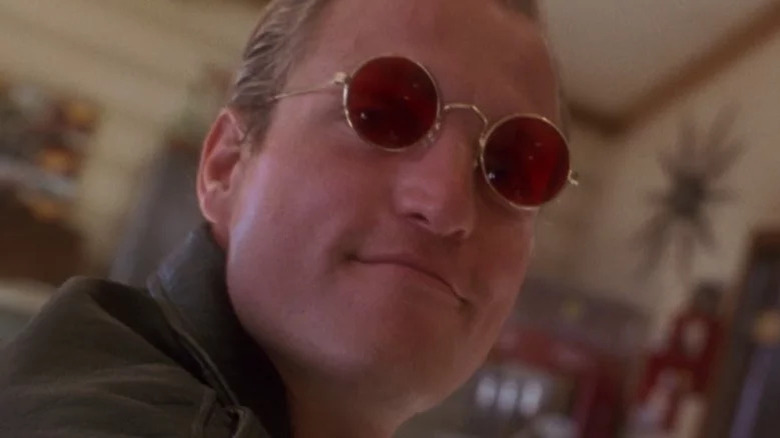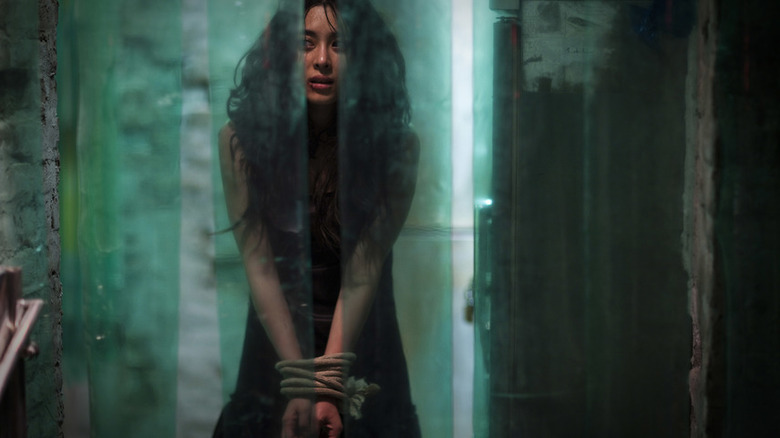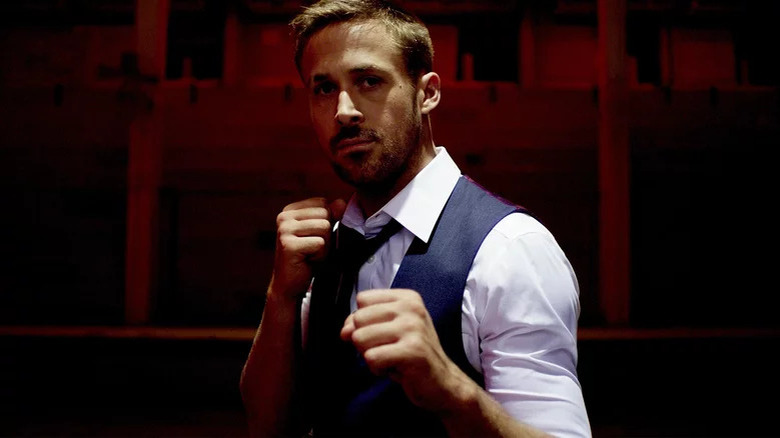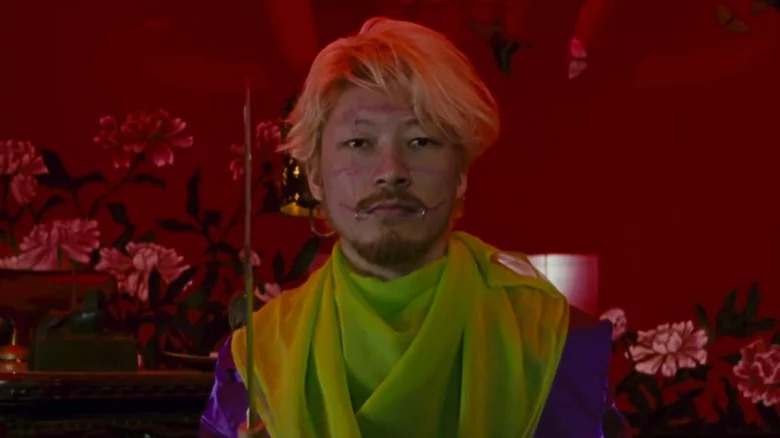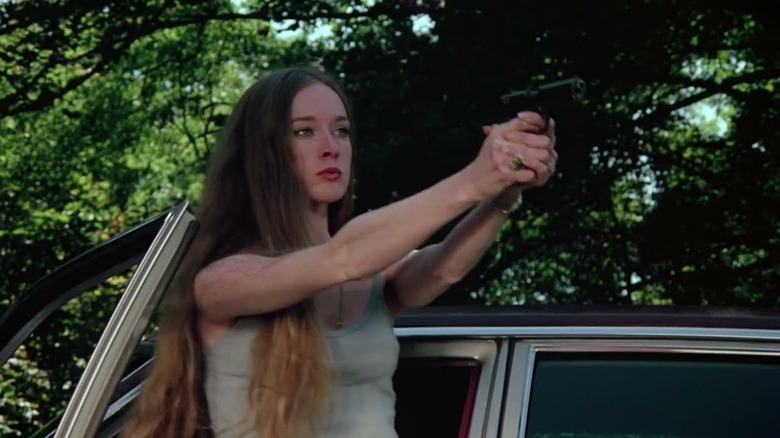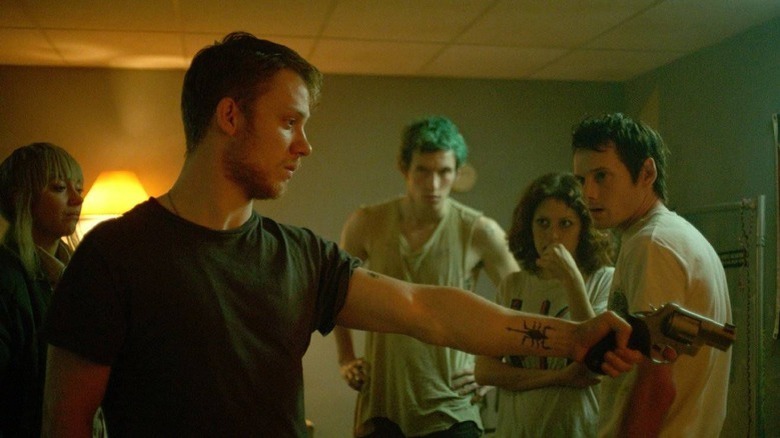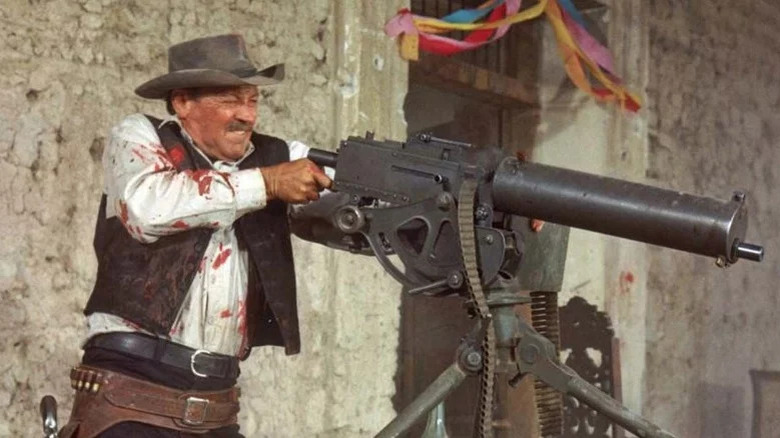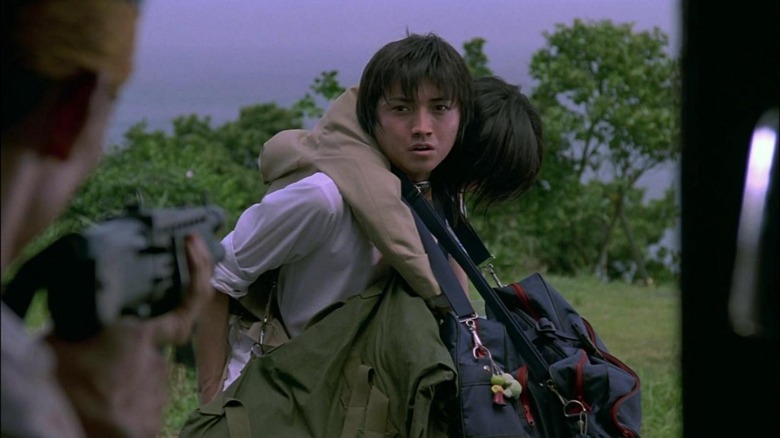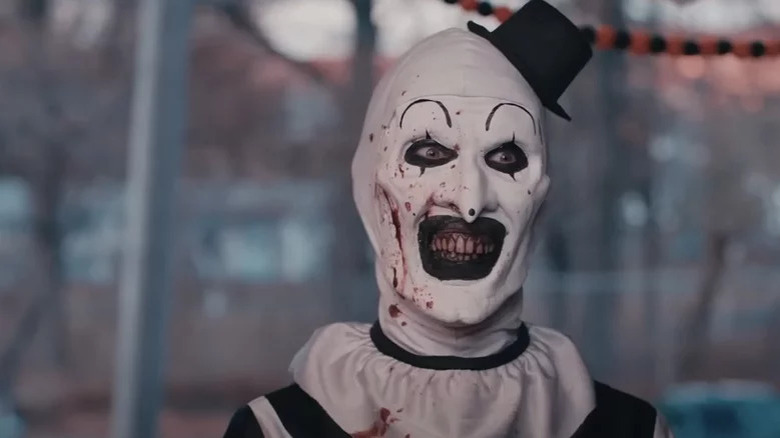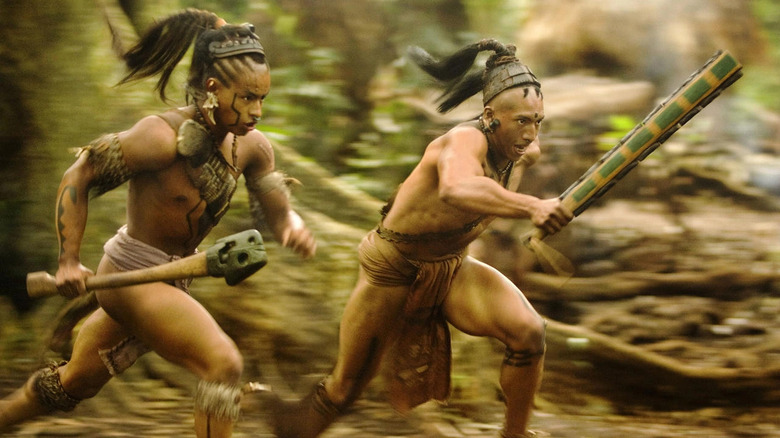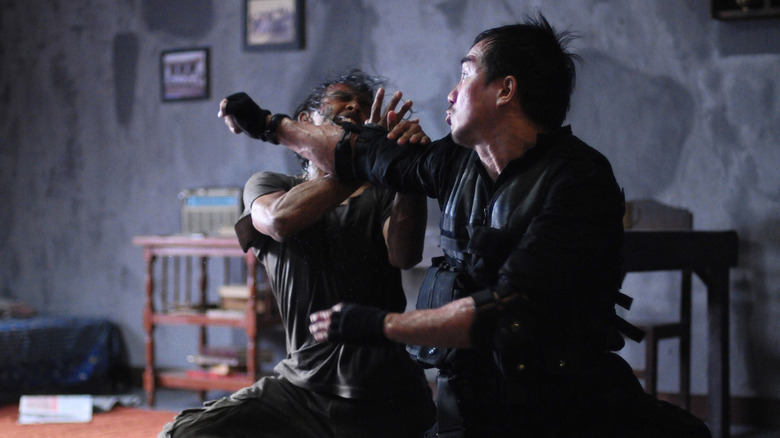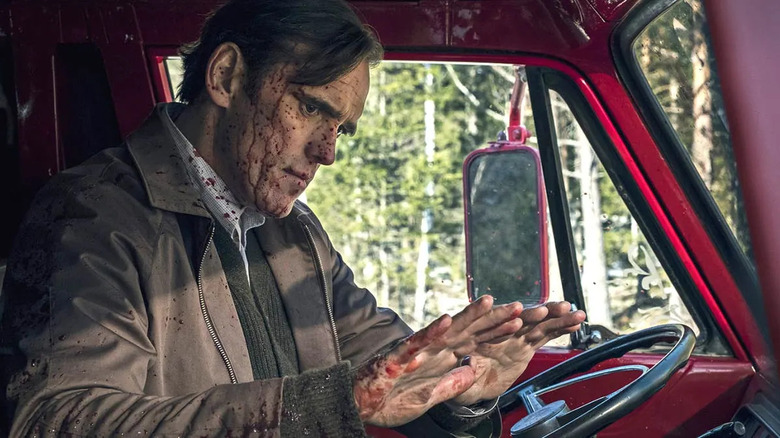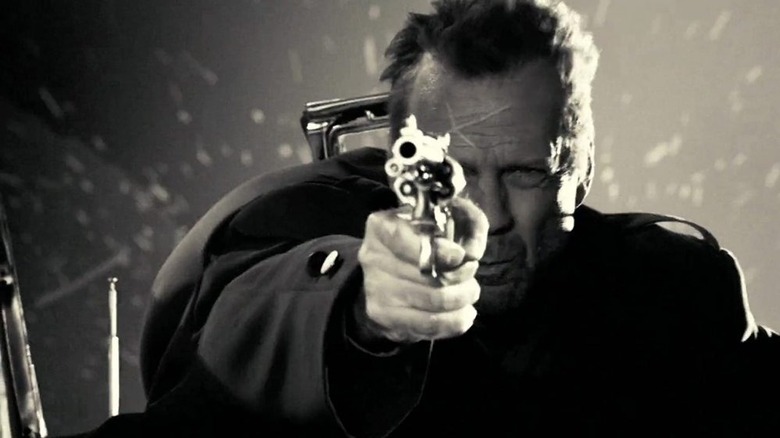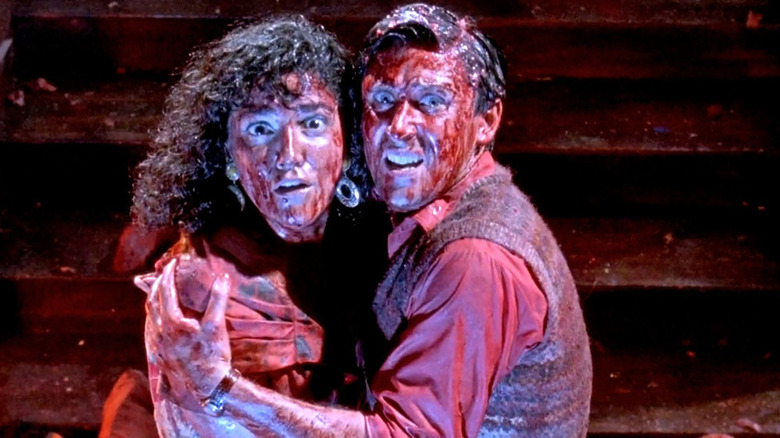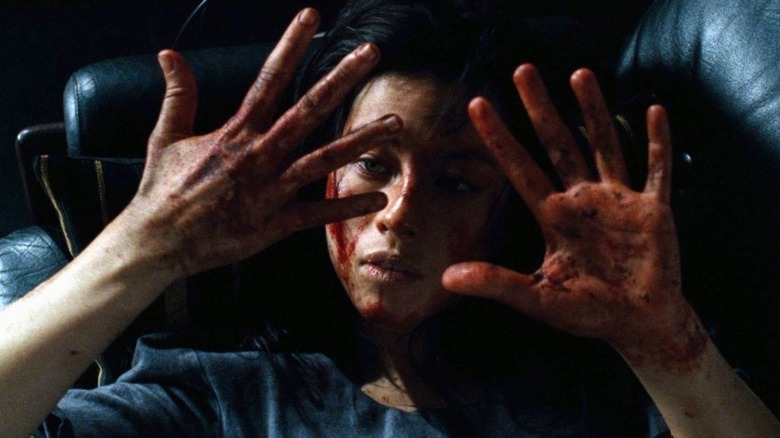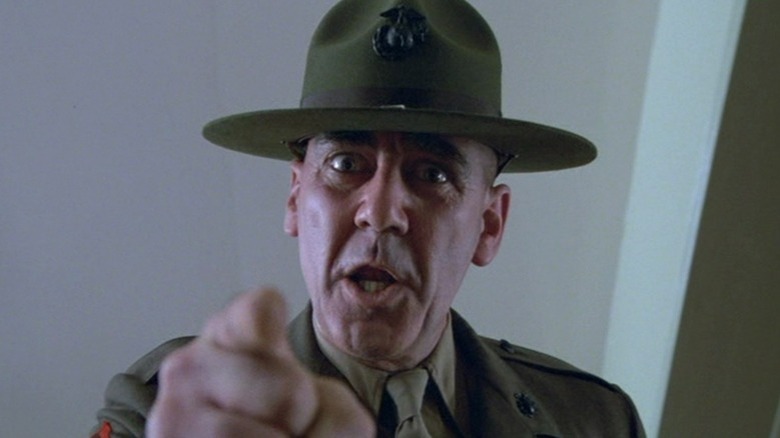The 20 Most Violent Films Of All Time
Violence has existed in movies since the beginning, and controversy followed quickly. In 1903, viewers were scandalized by the image of a man shooting at them at the end of "The Great Train Robbery." Since then there have been numerous movies that have stirred up conversations about violence on screen. From the effects of violent entertainment on children to the broader relationship between real and fictional violence depicted on screen and the seemingly ever-increasing violence in media both quantitatively and qualitatively.
It's no wonder then that a look at the most violent films ever made skews more recent as movies have continued to try to push the envelope as years go on, getting more intense with each year. But there are still those films that did it first, and sometimes more dramatically, than anything since has dared to follow.
While there's certainly significant overlap between the most violent and most disturbing films, the films we've selected below aren't only movies that are difficult to watch (though most are). And we've held ourselves back from overly relying on any existing lists of extremely violent movies, like the Video Nasties or films banned in any number of countries, though of course there's still some overlap. Instead, we've taken a look at several of the most violent films of all time across all decades, genres, and countries of origin, leading to a surprisingly diverse list of movies that can be described as "most violent" in a variety of ways.
Inside
Perhaps the most quantitatively violent movie to come out of the New French Extremity movement of the 2000s, "Inside" is barely over 80 minutes long, but is an onslaught of brutality for the majority of that time. The film follows the young pregnant widow Sarah (Alysson Paradis) who is spending Christmas Eve alone as she is attacked by a mysterious woman (Béatrice Dalle).
The woman isn't a random attacker though: She is specifically targeting Sarah so that she can remove Sarah's unborn child from her body and claim it as her own. It's a horrifying premise, but before the film gets anywhere near that procedure it shows a veritable parade of people coming through Sarah's home and encountering the unnamed woman. These encounters lead to some of the bloodiest and most viscerally thrilling — and disturbing — sequences of violence ever put to screen.
From Sarah's mother to her boss, to police who bring guns into the home and introducing new weapons to destroy the human body, "Inside" offers a nonstop barrage of violence to any viewers interested in such an experience. Clearly, there were enough fans of the original film to warrant a remake that doesn't hit quite as hard.
Cannibal Holocaust
One of the few movies to get its filmmaker arrested, "Cannibal Holocaust" was so believable that it led to director Ruggero Deodato being charged not just for obscenity but for murder. "Cannibal Holocaust" was one of the first movies to make use of the now much more commonly found footage techniques in a story about an anthropologist and rescue team who travel deep into the Amazonian jungles with the hopes of finding a film crew that went missing there.
What they find instead are the remains of the film crew and the footage that they shot. That footage is then shown in the film and is a horrifying extravaganza of violence. They didn't simply document the lives of the indigenous people they found in the jungle. They antagonized and tortured them by violently forcing them into a hut they then set fire to and sexually assaulting a young woman. But the indigenous people struck back, mutilating and raping the filmmakers in return.
It's a horrifying movie that's an assault on the senses made all the more difficult to stomach (and more worthy of inclusion on this list) because of the completely real violence against animals in the film. Monkeys are killed on screen, and a turtle is killed and hacked into several pieces. These sequences are incredibly hard to watch on their own, and the fact that they are real makes the practical effects of the human violence in the movie feel that much more real.
If you or anyone you know has been a victim of sexual assault, help is available. Visit the Rape, Abuse & Incest National Network website or contact RAINN's National Helpline at 1-800-656-HOPE (4673).
Saving Private Ryan
Steven Spielberg is one of the most storied and celebrated directors in Hollywood. He's been making movies for over 50 years and has made some of the most memorable and culturally important movies in a variety of genres. Despite all that, it's still somewhat surprising to think that Steven Spielberg, known for his emotional approach to filmmaking, made one of the most violent films of all time.
There's no denying that "Saving Private Ryan" is incredibly violent. The film's opening sequence of the Normandy invasion is iconic for the way that it brings the chaotic horror of war violence to the screen, drawing the audience into that overwhelming experience. But that's just one part of the war epic that lands it on this list. "Saving Private Ryan" goes on to include several brutal and devastatingly realistically portrayed scenes of war violence, from deaths by sniper rifles and machine guns, to one scene that many feel went too far.
"Saving Private Ryan" is a great war movie precisely because it forces the audience to face the harrowing reality of war violence, but it's also one of the most difficult movies to watch and one of the most violent films ever made.
Angst
Based on the crimes of real-life murderer Werner Kniesek, "Angst" follows an unnamed man (Erwin Leder) who is desperate to find someone he can kill. In voiceover, he explains that he wants to see the fear in the eyes of those he victimizes. And it's not long before the movie offers him just what he wants.
He breaks into a home where he finds an intellectually disabled man, a young woman, and their mother. He hides for a bit, simply watching the family, before launching his attack. From there the film is essentially nonstop terror, chasing, and violence as the unnamed man toys with the family as if they were simply playthings and not living human beings.
"Angst" is a disturbing but undeniably thrilling movie as it doesn't spend any time on characterization or plot, opting instead to introduce us to its world of horror as quickly and simply as possible. It's a movie that is more an experience than a narrative, and it's one of the most memorable cinematic experiences you can have.
Natural Born Killers
"Natural Born Killers" was extremely controversial when it first came out in 1994. It became more of a lightning rod for debate when it inspired several copycat crimes, leading to the real-life deaths of at least eight people. The great irony is that "Natural Born Killers" is explicitly about the relationship between violence and the media, albeit in the way that the media sensationalizes real violence not the effects of fictional violent media.
"Natural Born Killers" is also a satire, and therefore plays with excess, particularly excesses of violence. The film's over-the-top and seemingly endless scenes of violence are not meant to be taken entirely seriously, but there's no denying that these scenes brought an unbelievable amount of violence to the screen.
"Natural Born Killers" survived all the controversy it inspired and has become a cult classic, whether that's because of or in spite of the incredible amount of violence in the film we can't say, but we can say that it's one of the most violent movies of all time.
I Saw the Devil
Violent movies often run into issues with censors, and sometimes they do so more than once. Director Jee-woon Kim had to make significant cuts before it was approved for distribution in his native South Korea. But even with those cuts, "I Saw the Devil" is one of the most strikingly violent films of all time.
The movie follows National Intelligence Service (essentially the Korean CIA) agent Soo-hyeon (Lee Byung-hun) as he enacts protracted revenge on the serial killer who murdered his wife. That revenge plot is classic stuff, but where "I Saw the Devil" becomes something special, and something more extreme than any other revenge film, is in how Soo-hyeon enacts that revenge. He doesn't simply track down, torture, and kill his wife's murderer Jang Kyung-chul (the always fantastic Choi Min-sik). Instead, Soo-hyeon repeatedly finds, beats, and releases Kyung-chul, forcing him to live in a state of constant paranoia.
Over the film's lengthy runtime, we don't just see Kyung-chul's violence enacted on victims and Soo-hyun's brutal acts of revenge. The film also offers glimpses of what Kyung-chul's similarly sadistic friends do to their victims, including one man who is a cannibal. "I Saw the Devil" is a hard movie to watch that doles out maximal violence at such a frequent clip that it becomes normal.
Only God Forgives
After giving the world the modern classic "Drive," director and actor duo Nicolas Winding Refn and Ryan Gosling made a much less approachable movie (and to be fair, "Drive" isn't exactly a popcorn movie). "Only God Forgives" tells the story of Julian (Gosling), an American boxing club owner living in Bangkok where he and his brother use the club as a front for drug dealing.
When his brother is killed in retaliation for killing a young sex worker, Julian's mother Crystal (Kristin Scott Thomas) comes to Bangkok to force him to seek revenge on his brother's killer. But Julian thinks his brother deserved to die, leading Crystal to take matters into her own hands and expand the scope of her revenge to everyone involved with finding and killing her son in the aftermath of his crime.
"Only God Forgives" is an incredibly slow film that takes its time drinking in beautifully lit images. But that slowness makes the scenes of extreme violence hit that much harder. From a failed assassination attempt in a crowded street to the public torture and interrogation of a man and several severe uses of a sword, "Only God Forgives" is one of the most graphically violent movies ever made, whose moments of calm only accentuate the brutality of its violence. And it's worth noting too that the film portrays some incredibly hard-to-watch nonphysical interpersonal violence between Crystal and Julian that can't be ignored when we consider what counts as "violence."
Ichi the Killer
Many extremely violent movies are explicitly about violence, and that's very true of "Ichi the Killer," a movie that contains the line "there's no love in your violence" said in a genuinely sad and disappointed way. The movie follows the titular Ichi (Nao Ômori), who is manipulated by a yakuza boss into becoming an unthinking killing machine when called upon, and Kakihara (Tadanobu Asano), the enforcer who is sent to investigate Ichi's killings.
But Kakihara isn't just any gangster, he's a sadomasochist who truly loves violence. He believes that violence is an act of love, and we get to see this throughout the movie as he tortures and maims both enemies and himself. "Ichi the Killer" is a movie that celebrates violence in a way that few films do; it shows and seems to sympathize with Kakihara's joy in the tortures he unleashes on his victims. To be fair, it's somewhat easier to enjoy these scenes of violence knowing that every character in the movie is a bad guy. Kakihara's violence is contrasted with Ichi's who, when manipulated, becomes a killing machine that simply seeks to destroy without any reasoning.
"Ichi the Killer" is interested in violence and how people who are intimately familiar with it feel about violence, and because of that, the movie is one of the most violent films ever made. So violent in fact that it was banned in several countries.
I Spit on Your Grave (1978)
Revenge movies have a long history dating back to at least 1960 and the release of Ingmar Bergman's "The Virgin Spring." Perhaps none of them have made quite the same impact as 1978's "I Spit on Your Grave." The movie follows Jennifer (Camille Keaton), a writer who takes a vacation from her hectic life in Manhattan to a small town in Connecticut where she is violently assaulted by a group of men, and then seeks revenge.
The movie is still controversial for its assault sequence that takes up nearly 30 minutes of the film's runtime. But it's not 30 minutes of pure brutality. What makes this sequence even more difficult to watch is that there are pauses, moments that allow the audience to think that maybe Jennifer has escaped her assailants before they once again descend upon her. It's a stomach-churning experience that doesn't just push the boundaries of how much violence can be shown on screen, but how excessive that violence can be.
Of course, Jennifer's revenge is also incredibly violent, as she subjects most of the men to specific tortures for what they did to her, including significant violence against their genitals. "I Spit on Your Grave" is a horrifyingly violent movie, but there are those who find the film's extremity cathartic.
If you or anyone you know has been a victim of sexual assault, help is available. Visit the Rape, Abuse & Incest National Network website or contact RAINN's National Helpline at 1-800-656-HOPE (4673).
Green Room
When we consider "the most violent films of all time," there are just as many large-scale movies as there are small-scale ones, and "Green Room" may be the smallest. Almost the entire movie takes place in a single location: A venue run by white supremacists where the protagonists' band the Ain't Rights play a show, only to become trapped there when they discover a corpse.
From there the movie plays out like a siege film, with the Ain't Rights doing their best to survive, bargain, and finally, fight their way out. What makes "Green Room" land on this list is that the film contains some extremely memorable violent scenes, delivering a breakneck thrill fest despite — or perhaps because of — its small scale.
The violence in "Green Room" is notable for a number of reasons, but perhaps most of all is the way the movie shows machete and dog violence in ways never seen before. A character's arm is cut several times with machetes but doesn't simply get hacked off, instead showing the audience ribbons of flesh as the character's hand hangs on loosely to the rest of their body. And while most other movies cut away when a dog attacks, "Green Room" shows characters literally getting their throats ripped out by the animals.
The Wild Bunch
Sam Peckinpah is one of the most legendary directors in Hollywood history, largely because of the ways that he pushed violence further than anyone had done before. He's so important to the history of violence in cinema that there are books written about his filmmaking and violence. But perhaps no movie of his is more indicative of that relationship than 1969's "The Wild Bunch."
"The Wild Bunch" follows a group of outlaws as they try to find a place for themselves in the modern world while being chased by a group of bounty hunters led by a man who used to be part of their gang. It's a thoughtful and melancholy movie that takes time to develop its characters and themes, but it's also one of the bloodiest westerns ever made, with a final shootout that's become the stuff of Hollywood legend.
It's a film that uses its violence in service of its larger themes. "The Wild Bunch" is specifically interested in the ways that this violence is becoming a thing of the past, and that means the men at the center of the movie don't really have a place in the world anymore — but that might be a good thing.
Battle Royale
"Battle Royale" follows a class of young teenagers who believe they are going on a field trip, but have actually been selected to participate in a program the government has created to address juvenile crime. The program sets the students against one another in a — well you can probably guess — battle royale in which all students must fight one another to the death. There's no escape, as they are all outfitted with collars that will explode if they attempt to opt out of the battle.
The students are also given various weapons so that they can better fight one another, leading to a wide variety of deaths and dismemberments over the course of the film. "Battle Royale" is a movie that introduces the audience to its world and premise and then mostly just lets the battle play out, as students shoot, stab, and slice at one another.
"Battle Royale" lands on this list both for the incredible quantity of its violence, but also the quality. In one scene a character is castrated, and in another, a grenade is placed inside a recently decapitated head which then explodes. "Battle Royale" never plays this violence entirely seriously, but the movie was taken seriously by the countries that banned it.
Terrifier 2
"Terrifier 2" was a surprise breakout hit of 2022. The film was largely financed by fans and made for a budget of $250,000 but went on to gross over $10 million at the box office. But more than the film's financial success, what's most buzzworthy about it is the fact that several viewers reportedly fainted and vomited during some of the film's most disturbing scenes.
And there are quite a few of those scenes. While the first "Terrifier" has one indelible murder set piece, the sequel ups the ante and includes at least five extended murder sequences, and that's saying nothing of the violence that doesn't end in death. One of those murders committed by Art the Clown (David Howard Thornton), who has inexplicably returned to life after his death at the end of "Terrifier" to wreak more havoc in Miles County, takes up three separate scenes as the film drags out the torture that Art subjects his victim to.
It's not just the murder scenes that make "Terrifier 2" one of the most violent films of all time. The film's finale which sees final girl Sienna (Lauren LaVera) go head to head with Art takes up more than 20 minutes. That battle includes a variety of weapons and injuries including a flesh-ripping cat o' nine tails, a homemade mace outfitted with knives and forks at the head, and a possibly magical sword that's used to both stab bodies and sever limbs.
Apocalypto
Mel Gibson has had a long career in movies that has included starring roles in iconic movies, several professional and personal ups and downs, and directing one of the most controversial and successful movies of the 2000s. And while "The Passion of the Christ" certainly made a splash, we actually think it's Gibson's follow-up that's one of the most violent films of all time.
"Apocalypto" takes place in the early 16th century with a cast of Indigenous Mesoamericans who speak Yucatec Maya. The film follows Jaguar Paw (Rudy Youngblood) as his village is attacked and he is captured. It's a film that famously includes images of human sacrifice, but those are far from the only images of brutality in the film. The attack on Jaguar Paw's village is an extended scene of large-scale horror as homes are burned, and people are slaughtered. And later in the film, we see Jaguar Paw's captors use him and his community members for target practice.
It's a shockingly violent movie that offers no respite from the onslaught of cruelty it brings to the screen. In fact, the film portrays such a horrifically vicious world that some have argued is not just inaccurate but in fact harmful to the descendants of the Maya.
The Raid
"The Raid" was massively influential to the action movies of the 2010s. It introduced brutality and simplicity that became touchstones of the genre. "The Raid" also specifically inspired the approach to action in the "John Wick" franchise, which in its third installment included a scene where Keanu Reeves faces off against actors who appear in "The Raid" and its sequel.
The film brings the Indonesian martial art of Pencak Silat to the screen with a simple story that allows the movie to focus entirely on the action. The plot follows a group of police who are tasked with storming a high-rise building and bringing in the crime lord who lives at the top. But when that crime lord learns that there are cops in his building, he offers a reward to any residents willing to stop the police leading to all-out chaos.
"The Raid" is a thrill ride from start to finish, pausing briefly to allow the audience to catch their breath. Between incredible fights that mix hand-to-hand combat with gunplay and knife fights, "The Raid" is a movie that's both brutal and incredibly fun. "The Raid" wouldn't land on our list of the most violent movies of all time if it didn't deliver on the extremity in its violence as well, and there are scenes of violent death here that use everything from broken door frames to fluorescent light tubes to deliver the finishing blows.
The House That Jack Built
Lars von Trier is one of the most controversial directors of all time, and "The House That Jack Built" certainly only helped to cement that reputation. The film follows the titular Jack (Matt Dillon), a serial killer, as he and a mostly unseen conversation partner consider five murders Jack committed over the course of his life. It's a movie that doesn't have a plot aside from showing the audience five different instances of violence.
Each sequence is distinct but disturbing as we see Jack kill in a variety of ways and for a variety of reasons. These sequences include a scene of child murder, a forced at-home mastectomy, and an experiment during which Jack wants to see how many people he can kill with a single bullet if he lines their heads up just right. What makes these scenes even more difficult to watch is the matter-of-fact way that von Trier portrays the murders, often simply allowing them to play out without much music or any dramatic camera choices.
"The House That Jack Built" is especially horrifying not because of the violence of the film, but the fact that the movie is often surprisingly funny. It's a trick that von Trier seems to play on his audience, forcing us to realize that we can laugh at, and even sometimes laugh with, Jack in the midst of all this bloodshed.
Sin City
It may be somewhat surprising to see a movie based on a comic book on a list of the most violent movies of all time, but "Sin City," written and co-directed by Frank Miller, absolutely earns its place. The hyper-stylization of the film makes the violence that much more striking while also lending it an otherworldly quality that makes it removed from reality.
The film offers the audience several vignettes of stories that take place in and around the fictional Basin City. Each of these stories includes significant and horrific violence perpetrated by villains, from cannibalism to sexual assault of children, and by heroes, who decapitate and castrate the villains.
"Sin City" feels inspired by the noir films of the 1940s and '50s and seems determined to include all the violence that those films could not because of the censorship of the time. "Sin City" is a rare comic book movie that's just not for kids because of its violence, but it's too intense for a lot of adults as well.
If you or someone you know may be the victim of child abuse, please contact the Childhelp National Child Abuse Hotline at 1-800-4-A-Child (1-800-422-4453) or contact their live chat services.
Braindead
"Braindead," also known as "Dead Alive," is an early film from "The Lord of the Rings" and "The Hobbit" director Peter Jackson. Before turning to epic high fantasy, Jackson specialized in horror comedy splatter films, and "Braindead" may be his masterpiece in that subgenre. The film follows a young man in Wellington, New Zealand who has to first attempt to contain a zombie-creating infection and then fight the ever-growing horde of zombies when he can't stop the spread.
The film mixes over-the-top gore and silly humor for a tone that's much more jovial than horrifying, but it's still some of the most stomach-churning stuff ever set to film. From a scene where a pus-filled boil explodes into a bowl of custard that someone then unknowingly eats to the film's grand finale in which the hero takes a lawn mower to the crowd of zombies literally mowing them down, "Braindead" offers enough disgusting and bloody imagery to last a lifetime.
It's a movie that serves as a good reminder though that not all extremely violent movies are horrific or brutal, and that sometimes violence can be played with a tone that's more guffaw-inducing than gag-inducing.
Martyrs
Like "Inside," "Martyrs" is a film that came out of the New French Extremity movement in the 2000s. But unlike "Inside," "Martyrs" has become a cultural touchstone in a way that few horror movies have. It's not only considered one of the scariest horror movies of all time, but also one of the hardest horror movies to watch more than once.
That distinction between the films has nothing to do with one being more violent than the other. In fact "Inside" may actually be more violent, but the way that "Martyrs" presents its violence in its second half is arguably more disturbing. The film follows Lucie (Mylène Jampanoï), a young woman who was kidnapped and tortured as a child, as she finds and exacts revenge on the family that tortured her before shifting gears to center on her friend Anna (Morjana Alaoui) and her experiences with the people who tortured Lucie. That first half is brutal and full of violence, but it's the chaotic violence we get in most revenge films, the second half shows violence that's much more methodical and passionless.
It's that detached dispensing of cruelty that makes "Martyrs" such an impactful film that horrifies people and makes it difficult to return to. The movie presents much of its extreme violence as something not necessarily born in the chaos of a moment, but rather something planned and executed without a shred of emotion which makes it stand as one of the more unique movies to include massive amounts of violence.
Full Metal Jacket
Stanley Kubrick is no stranger to controversy, particularly with his film "A Clockwork Orange." But we think it's actually his penultimate film "Full Metal Jacket" that is the most violent film he ever made, and one of the most violent films of all time.
"Full Metal Jacket" tells the story of a platoon of young soldiers from their time in boot camp to their experiences in the Vietnam war. It's a film split into two distinct halves. One might expect the film's second half, in which the soldiers must fight in active combat, to be the more memorably violent part of the film. However, it's actually the structural violence of the first half that makes "Full Metal Jacket" such a classic war film.
We see a drill instructor hurl obscenities and cruel remarks at the recruits, especially one chubby recruit who he nicknames Pyle (Vincent D'Onofrio). The drill instructor institutes a policy of collective punishment that then turns the other recruits against Pyle. It's a shocking series of events that culminates in one of the most shocking moments in cinema history.
But just because the first half of the film is more memorably violent, doesn't mean the latter half isn't. The war scenes show a number of graphic violent deaths as well as an extended death scene of a young girl. "Full Metal Jacket" is a movie that attempts to address the different types of violence endured by soldiers and in doing so delivers one of the most strikingly violent movies ever made.
